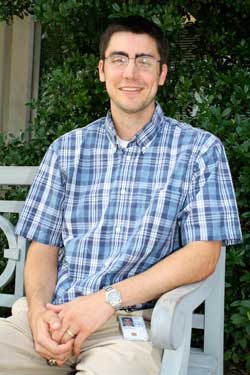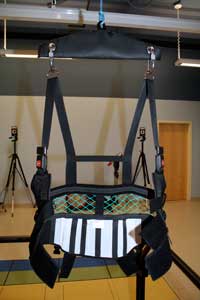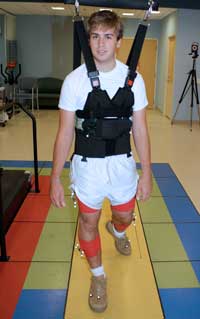 |

|
|
Chris Stanley, Biomedical Engineer, Engineer, Rehabilitation Medicine Department, Clinical Center, National Institutes of Health (NIH)
|
1. I chose this career because...
2. My typical workday involves...
3. What I like best/least about my work...
4. My career goals...
5. When I'm not working, I like to...
|
|
1. I chose this career because...
|
Back to Top

|

|
|
A harness that is secured to the ceiling gives walking assistance to patients who need support or have problems with balance, while movement tests are performed in the clinic.
|
I chose to become a biomedical engineer because it combined my classroom skills with my interests. I have always excelled in math and science, and I knew entering college that engineering combined those subjects. My dad is an engineer, and so I followed his lead in pursuing the field. My personality fit well with Industrial Engineering (IE), because it requires attention to detail and efficiency of complex systems. IE is a broad field, but it mostly deals with manufacturing operations and systems.
I have always been fascinated by the human body and spent most of my time playing sports, which led me to become interested in applying engineering principles to the human body. Biomechanics is the field that blends these interests so I decided to study this in graduate school.
Education
Bachelor of Science, Industrial Engineering, Pennsylvania State University, University Park, Pennsylvania
Master of Science, Human Movement Science, University of North Carolina, Chapel Hill, North Carolina
|
|
2. My typical workday involves...
|
Back to Top

|

|
|
A patient walks along a marked pathway in the clinic while infrared cameras capture his movements by “seeing” the reflective markers that are attached to his legs.
|
My typical workday involves research projects aimed at understanding and improving patient movement and function. I work with a team of other health care professionals including scientists, physical therapists, physicians, and engineers to quantify human movement. Many of our intervention studies involve patients (adults and children) with cerebral palsy. Cerebral palsy is a neurological disorder that affects body movement, balance, and muscle coordination. Most of my time is spent collecting and processing patient data. I use a special camera system to collect data on patients’ movements and then analyze the data using software that was designed here at the NIH.
Our Current Research Studies
An Exercise Program – We develop exercise programs that incorporate the use of exercise bicycles and elliptical machines with the goal of improving patient’s walking ability. Patients are trained on the machine for three months. We run tests before and after the intervention to see if the exercise training improves their walking and balance.
A Functional Electrical Stimulation Device – Patients in this study wear an electrical stimulation device that aids walking by helping them lift the front part of the foot up more than usual. We can see the device is working because it does lift their foot when they wear it. However, we want to determine if it is training the body long term such that the improvements in their walking remain even when they are not wearing it.
My Equipment: Cameras
In the laboratory, we use 10 infrared cameras to capture movements of the body. Our three major assessments include: walking, balance during standing, and upper extremity reaching. We place reflective markers on specific locations of the body, and the cameras capture the markers as the patient moves, which can be viewed on a computer. Looking at the computer, you see only the reflective markers. We tell the computer what each marker represents, and it enables us to create a bone model specific to each patient, which than allows us to analyze their movements. This is the same type of technology that is used to make animated movies and video games.
My Major Tasks
- Setting-up the laboratory – When we have a patient coming in, I spend the morning setting up laboratory equipment, and calibrating cameras used in our studies.
- Preparing a patient for the test – Once the patient arrives, I work with a physical therapist to prepare the patient for data collection, which includes placing the reflective markers and EMG electrodes.
- Instructing a patient and collecting data – I ask the patient to walk, hold a position, or do other types of movement, while I record the data on a computer and do some quality control using the real-time data.
- Analyzing data – I use several different software packages to help me analyze all the patient data collected during the test.
|
|
|
 |